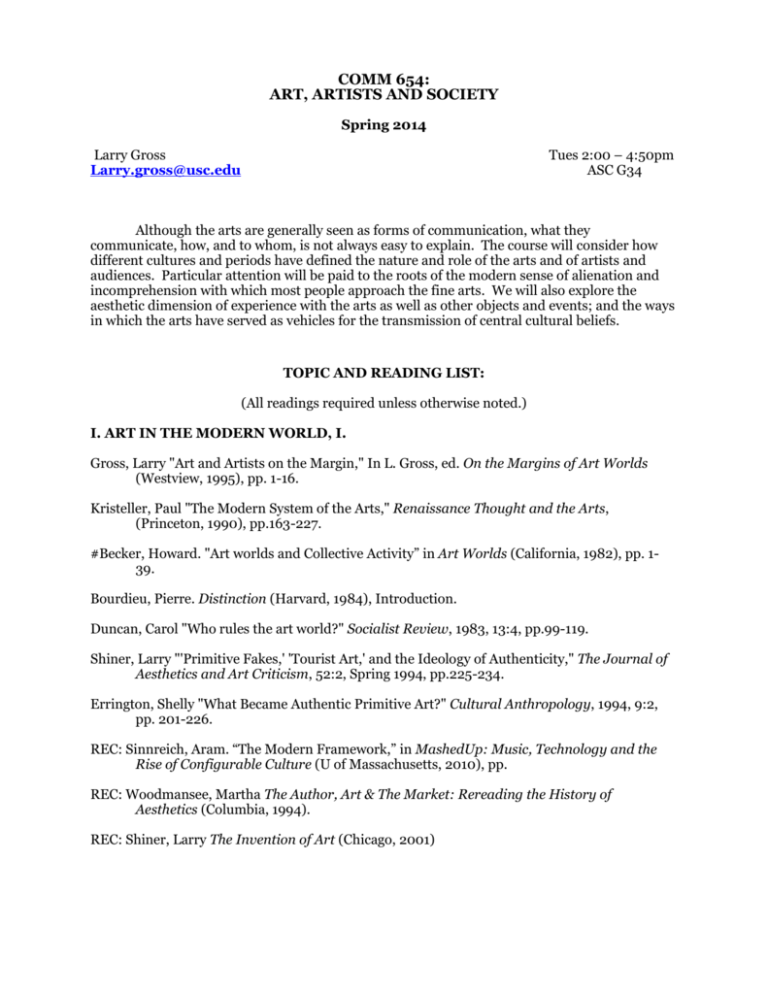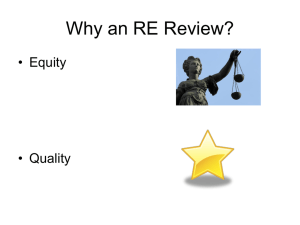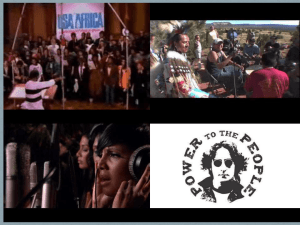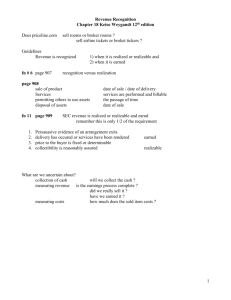COMM 544: - University of Southern California
advertisement

COMM 654: ART, ARTISTS AND SOCIETY Spring 2014 Larry Gross Larry.gross@usc.edu Tues 2:00 – 4:50pm ASC G34 Although the arts are generally seen as forms of communication, what they communicate, how, and to whom, is not always easy to explain. The course will consider how different cultures and periods have defined the nature and role of the arts and of artists and audiences. Particular attention will be paid to the roots of the modern sense of alienation and incomprehension with which most people approach the fine arts. We will also explore the aesthetic dimension of experience with the arts as well as other objects and events; and the ways in which the arts have served as vehicles for the transmission of central cultural beliefs. TOPIC AND READING LIST: (All readings required unless otherwise noted.) I. ART IN THE MODERN WORLD, I. Gross, Larry "Art and Artists on the Margin," In L. Gross, ed. On the Margins of Art Worlds (Westview, 1995), pp. 1-16. Kristeller, Paul "The Modern System of the Arts," Renaissance Thought and the Arts, (Princeton, 1990), pp.163-227. #Becker, Howard. "Art worlds and Collective Activity” in Art Worlds (California, 1982), pp. 139. Bourdieu, Pierre. Distinction (Harvard, 1984), Introduction. Duncan, Carol "Who rules the art world?" Socialist Review, 1983, 13:4, pp.99-119. Shiner, Larry "'Primitive Fakes,' 'Tourist Art,' and the Ideology of Authenticity," The Journal of Aesthetics and Art Criticism, 52:2, Spring 1994, pp.225-234. Errington, Shelly "What Became Authentic Primitive Art?" Cultural Anthropology, 1994, 9:2, pp. 201-226. REC: Sinnreich, Aram. “The Modern Framework,” in MashedUp: Music, Technology and the Rise of Configurable Culture (U of Massachusetts, 2010), pp. REC: Woodmansee, Martha The Author, Art & The Market: Rereading the History of Aesthetics (Columbia, 1994). REC: Shiner, Larry The Invention of Art (Chicago, 2001) Spring 2014 ART, ARTISTS AND SOCIETY 2 II. ART AND SYMBOLIC COMPETENCE Gross, L. "Modes of Communication and the Acquisition of Symbolic Competence," in D.R. Olson, ed. Media And Symbols (Chicago, 1974). Gross, L. "Art as the Communication of Competence," Social Science Information, 12, 1973. Polanyi, Michael The Tacit Dimension (Anchor, 1967), 1st 2 chaps. Polanyi, Michael. Personal Knowledge (Chicago, 1958), Chapter 4: "Skill," pp. 49-58. #Herrigel, Eugen Zen in The Art Of Archery (Vintage, 1953). Bateson, Gregory "Style, Grace and Information in Primitive Art," Steps To An Ecology Of Mind (Ballantine, 1972) pp. 128-152. REC: Gardner, H. Frames Of Mind: The Theory of Multiple Intelligences (Basic Books, 1983), Chapters 1, 4 and Part 2. REC: Bloom, Paul How Pleasure Works: The New Science of Why We Like What we Like [Norton, 2010], Chapter 5: “Performance,” pp. 117-154. III. COMMUNICATING MEANING AND EMOTION Gross, L. "Life vs Art: The Interpretation of Visual Narratives," Studies In Visual Communication, 1985, 11:4, pp.2-11. Slonimsky, Nicholas A Lexicon of Musical Invective (Washington, 1965), Chapter 1: "Nonacceptance of the unfamiliar," pp. 3-33. #Meyer, Leonard B. Emotion And Meaning In Music, (Chicago, 1956), pp.1-91. Keil, Charles "Motion and Feeling Through Music," in Keil and Feld, Music Grooves (Chicago, 1994), pp. 53-76. REC: Feld, Steve "Communication, Music, and Speech About Music," in Keil and Feld, Music Grooves (Chicago, 1994), pp. 77-95. Fussell, Paul Poetic Meter And Poetic Form, (Vintage, 1965), Chapters 1 and 9 Steinberg, Leo "The Glorious Company," in J. Lipman & R. Marshall, eds. Art About Art (Dutton, 1978), pp.8-31. #Ivins, William Prints And Visual Communication (MIT, 1953) Chapters 2, 7 and 8 (rest recommended). Spring 2014 ART, ARTISTS AND SOCIETY 3 IV. CODES AND CONTEXTS #Baxandall, Michael Painting and Experience In 15th Century Italy, (Oxford, 1972). Gross, L. "Art History as Ethnography and as Social Analysis," Studies in the Anthropology Of Visual Communication, 1974, 1:1, PP.51-56. Steinberg, Leo. "Contemporary Art and the Plight of Its Public," in Other Criteria, (Oxford, 1972), pp, 3-16. Mulkay, M. & E. Chaplin "Aesthetics and the Artistic Career," The Sociological Quarterly, 1982, 23, pp. 117-138. Pollock, Griselda "Artists Mythologies and Media Genius: Madness and Art History," Screen, 1980, 21:3, pp.57-96. Blacking, John How Musical Is Man? (Washington, 1974). Green, Lucy “What is it to be musically educated?” How Popular Musicians Learn, Chapter 1 (Ashgate, 2002), pp. 1-20 [esp. 1-8]. REC: Becker, H. Artworlds (California, 1982), Chapters 2-11. V. THE CONTENT OF SHAPE Sypher, Wylie Four Stages Of Renaissance Style (Anchor, 1955), pp. 1-36. Wittkower, Rudolph Architectural Principles In The Age Of Humanism (Random House, 1962), pp. 2-32. REC: Sypher, Wylie. From Rococo to Cubism (Vintage, 1963), Forward and Chapters 1-2. REC: Norberg-Schulz, Christian. Meaning in Western Architecture (Praeger, 1975). REC: Capra, Fritjof. The Tao of Physics [Shambala, 1975]. REC: Dallmayr, Fred. “Western thought and Indian thought: Some comparative steps,” Beyond Orientalism: Essays on Cross-Cultural Encounter [SUNY Press, 1996], pp. 135-148 REC: Nisbett, Richard. The Geography of the Thought: How Asians and Westerners Think Differently… and Why [Free Press, 2004]. VI. ART IN THE MODERN WORLD, II. Fisher, Phillip "The Future's Past," New Literary History, 6:3, 1975, ppp.587-606. Charbonnier, Georges. Conversations with Claude Levi-Strauss. (Cape, 1969). Gross, L. "The Price of Progress" published as "How True is Television's Message," in Getting the Message Across, (UNESCO, 1975), pp.23-52. Williams, Raymond. Culture and Society (Harper, 1960), pp.295-338. Spring 2014 ART, ARTISTS AND SOCIETY 4 #Berger, John. Ways of Seeing (Penguin, 1972). #Spalding, Julian. The Eclipse of Art: Tackling the Crisis in Art Today (Prestel, 2003). Literat, Ioana. “The Work of Art in the Age of Mediated Participation: Crowdsourced Art and Collective Creativity,” International Journal of Communication, 2012, Vol. 6, 29622984 [http://ijoc.org/index.php/ijoc/article/view/1531/835 ] ADDITIONAL READINGS TO COME… REC: Benjamin, W. "The Work of Art in the Age of Mechanical Reproduction," in Illuminations (Schocken, 1969), pp.217-252. # -- Books – best ordered online Other readings on Blackboard ASSIGNMENTS 45% 45% 10% Mid-term take-home exam Final take-home exam Class Participation LEARNING OBJECTIVES The objectives of the course include acquiring: Familiarity with the ways in which the arts can be considered to be modes of communication, and what messages are conveyed through the arts; Culturally and historically grounded concepts and terminology for appreciating how the understanding of the arts has varied across time and space; An awareness of the specific historical and cultural roots of the alienation of the arts from mainstream society that have characterized modern Western cultures; The ability to navigate the overlapping territories of the arts and the mass media in the contemporary world. ACADEMIC INTEGRITY The Annenberg School of Communication is committed to upholding the University's Academic Integrity Code as detailed in the SCampus Guide. It is the policy of the School of Communication to report all violations of the code. Any serious violation or pattern of violations of the Academic Integrity Code will result in the student's expulsion from the Communication major or minor. Any Student requesting academic accommodations based on a disability is required to register with Disability Services and Programs (DSP) each semester. A letter of verification for approved accommodations can be obtained from DSP. Please be sure the letter is delivered to me (or to TA) as early in the semester as early as possible. DSP is located in STU 301 and is open 8:30 a.m. - 5:00 p.m., Monday through Friday. The phone number for DSP is (213) 740-0776.”







